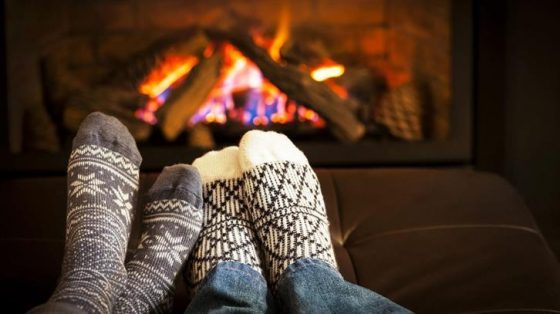
Those who choose to heat their home with wood are becoming fewer and fewer. However, with more interested in a self-sustaining lifestyle and going off the grid, those numbers may begin to rise again. If you decided to heat your home with wood, there are simply some types of wood that are better to burn in your home.
There is nothing quite like a roaring fire to stand next to while listening to the crackles and pops on a subzero winter day while there’s a raging snowstorm blowing through. If you live in an area where those days are common in the winter, you probably know the benefits of having a wood burning stove firsthand. The heat is immediate and fills the space quickly as opposed to waiting for propane or electric heat to keep up. It’s also oddly comforting.
When talking about burning wood inside for heat, it is important to first talk about the quality of your wood burning stove. Using wood as the main heat source in your home is not for everyone. It’s actually lifestyle choice. Many summer days will be spent cutting and splitting wood to be used during the winter months and if you choose to buy firewood, the cost may not outweigh the benefits. In my little slice of Wyoming, a cord of wood that is already split and ready to go sell go for as much as $255 per cord for lodgepole pine which is a rather high price compared to many other areas. We use around 5-7 cords per year. The number of cords used will vary based on the quality of your stove, the intensity of the winter, and the size of your home. (We have this wood burning stove and an over 2000 sq foot home.) If you choose to cut your own firewood, that cost will go down to the price of a firewood permit, which is $20 and will allow you to cut 4 cords, the fuel to get the wood home, wear and tear on your equipment, and your labor.
 Of course, the main benefit of using a wood burning stove is that it is not dependent at all on electricity. If a winter storm blows through and we are out of power for days on end, we are at the very least, warm and comfortable. There is also the added bonus that you can even use your wood stove to cook a few meals if you have to. It isn’t my favorite way to make a meal because you have to get the stove so hot it’s uncomfortable to do so, but it can be done in pinch!
Of course, the main benefit of using a wood burning stove is that it is not dependent at all on electricity. If a winter storm blows through and we are out of power for days on end, we are at the very least, warm and comfortable. There is also the added bonus that you can even use your wood stove to cook a few meals if you have to. It isn’t my favorite way to make a meal because you have to get the stove so hot it’s uncomfortable to do so, but it can be done in pinch!
So what exactly makes some types of firewood better for burning than others? It comes down to two factors: density and water content. The more dense and drier the firewood, the better it will burn and the more heat it can produce in your wood burning stove. Because of this, hardwoods, which tend to be denser, generally make for better firewood than softwoods. Make sure they are dry, however.
1 cord = 200 to 250 gallons of fuel oil (hardwoods) High Heat Value
- American beech
- Apple
- Ironwood
- Red oak
- Shagbark hickory
- Sugar maple
- White ash
- White oak
- Yellow birch
1 cord = 150 to 200 gallons of fuel oil, Medium Heat Value
- American elm
- Black cherry
- Douglas fir
- Red maple
- Silver maple
- Tamarack
- White birch
1 cord = 100 to 150 gallons of fuel oil, Low Heat Value
- Aspen
- Cottonwood
- Hemlock
- Lodgepole pine
- Red alder
- Redwood
- Sitka spruce
- Western red cedar
- White pine
Many of these types of hardwood listed above are not readily available to those living in the pine-dense forested areas of the Rocky Mountains. For that reason, a wood that can be used is Juniper, if you can get your hands on it. It is wonderfully fragrant with a cedar-like aroma. It has medium hardness and mixes well with other woods while burning. Alligator juniper is excellent in the fireplace or in a backyard fire pit and produces a cozy lively fire with crackle, pop, and pleasant aroma. It’s a wood used by many of Arizona’s elite resorts. Utah juniper or cedar is slightly less expensive than alligator juniper and has the same burning qualities. The shaggy bark can provide a nice kindling for your fire and although Utah juniper also has medium hardness, it burns clean and mixes well with any hardwood.
Lodgepole pine is another option as juniper is often difficult to get. This is the wood we choose to use based on our location, efficiency, and how easy it is to find. It has a lower heat value than the hardwoods, but it is readily available. It also has a good straight grain for splitting, it creates a quick hot fire and leaves very little ash. Your selection of firewood should align with the area you live in. There isn’t much sense to made of looking for a sugar maple tree to cut down to heat your home when you live in Wyoming. Therefore, the “best” wood is what you can find, cut, and split easily.
Make sure you “season” or dry your wood before use too. This will help with efficiency too. Wet wood is easier to split than dry wood, however, once split, it should be stacked to dry under cover and out of the rain for six months. If steam bubbles and hisses out of the end grain as the firewood heats up on the fire, the wood is still too wet, or green, and needs to be seasoned longer before burning. Well-seasoned firewood generally has darkened ends with visible cracks or splits. It is relatively lightweight and makes a sharp, distinctive “clink” when two pieces strike each other.
Heating your home with wood in a wood burning stove is about as cozy and comfortable you can get, however, be prepared for hard work to get ready for the winter season.

This article was originally published at Ready Nutrition™ on October 10th, 2018






